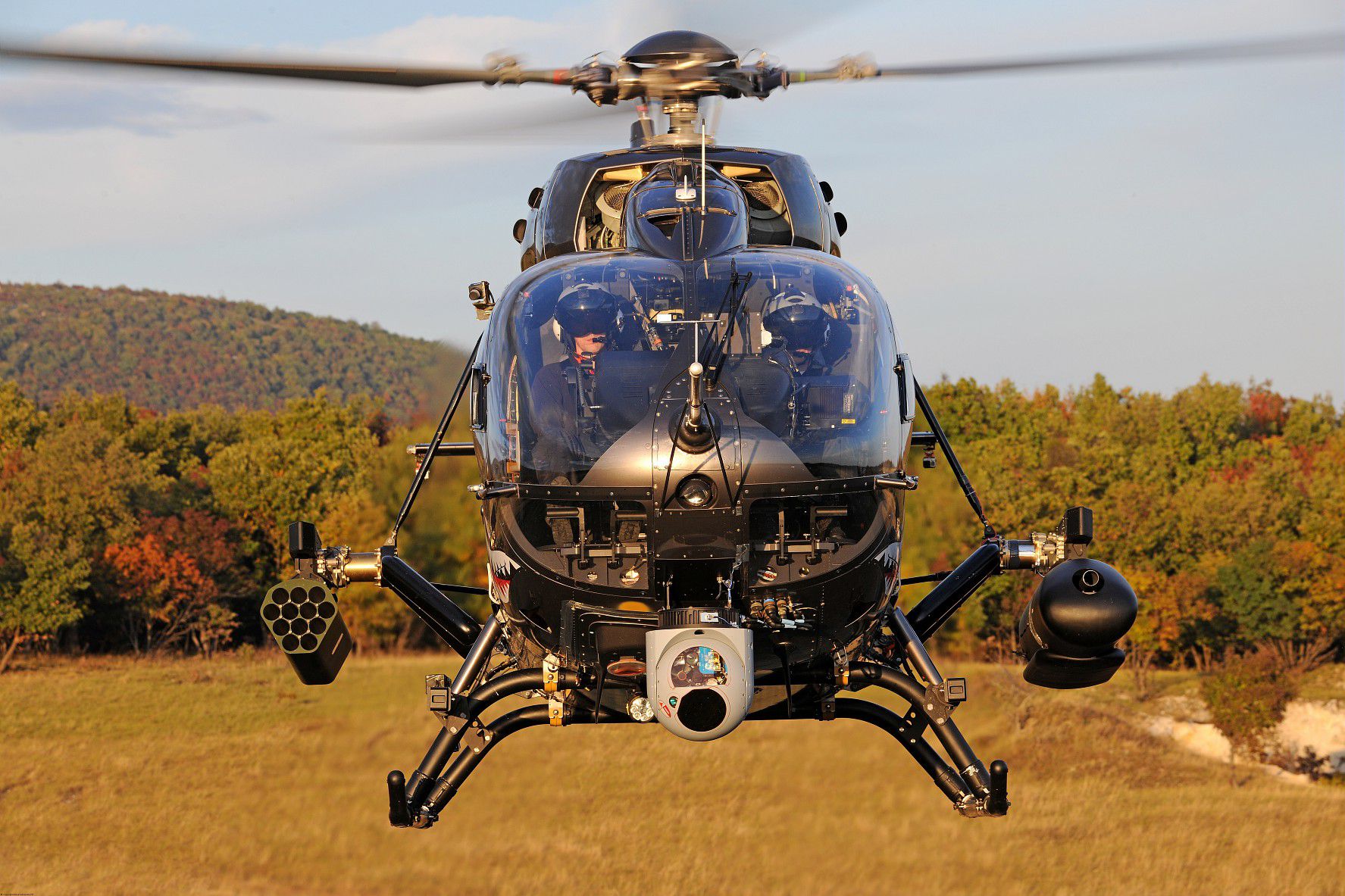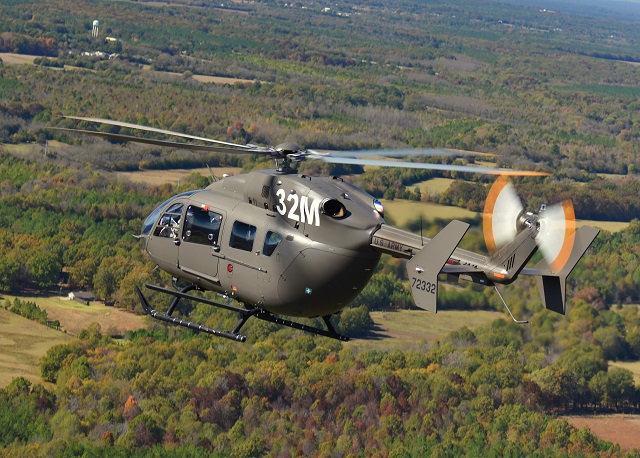Despite an initial setback, Airbus Helicopters is gradually seeing momentum build for its HForce modular weapons system and has ambitions for the concept that even encompass a sale to the USA.
Launched in 2016, HForce is means of arming any helicopter in the airframer's range, with the exception of the H175.
At its core is a Rockwell Collins mission computer, coupled to which is a Thales Scorpion helmet-mounted display. Beyond that, however, is a selected menu of weapons and sensors, ranging all the way from a simple 12.6mm podded machine gun at one end, to guided missiles at the other.
Although HForce is platform agnostic, Airbus Helicopters has initially confined the integration work to three platforms: the H125M light-single; H145M medium-twin; and H225M heavy-twin.
HForce was initially expected to debut on the H225M – largely driven by a now-cancelled Polish requirement – but the airframer is actually finding most success with the H145M.
Airbus Helicopters has so far amassed three customers for HForce: Serbia will be the launch operator, taking its first of six H145Ms equipped with the system in 2019, with deliveries to Hungary following the year after, also using the same platform.
Both central European nations are acquiring armed helicopters – Hungary's are in a more advanced configuration, featuring both ballistic weapons and guided rockets. Budapest is buying 20 helicopters, with weapons kits for around half the total.
However, a third, undisclosed operator – understood to be Singapore – is taking what Airbus Helicopters refers to as "option zero" on its fleet of H225Ms: fixed components and wiring harnesses are pre-installed, but the helicopters are not armed.
Aside from that baseline option, HForce comes in three levels of sophistication: option one, for light scout missions, features only ballistic weapons – a Nexter 20mm cannon or FN Herstal 12.6mm gun, plus unguided 68mm Thales rockets; option two adds an L-3 Wescam MX-15 electro-optical/infrared turret; while option three, as a light attack platform, adds 70mm Thales guided rockets as well as guided missiles.
Interest in the concept appears to be growing: in late July, Airbus Helicopters, in collaboration with the Hungarian defence ministry, held the first of two rounds of flight and firing demonstrations for prospective customers using a H145M test aircraft.
Conducted at the Bakony combat training centre around 55 miles (90km) from Budapest, the effort has seen military delegations present from a swathe of countries: some, like Austria and Kazakhstan, have declared requirements for medium-class helicopters, others, notably Australia and Germany, are in the early pre-contest stages, and there is even a delegation from the USA, which is not entirely sure what kind of capability – if any – it requires.
A group from the Czech Republic was also in attendance, perhaps a surprise given that a now-paused procurement had whittled the field down to the larger Bell UH-1Y Viper or Leonardo Helicopters AW139M.

Airbus Helicopters
"One of the Czech delegation said he could not keep the smile off his face when I asked him how the flight was," says one Airbus Helicopters insider. "He said they might have to change the requirement as a result."
Around 30 campaigns are ongoing involving HForce, the majority using the H145M, says Christian Fanchini, head of operational marketing. The four countries previously mentioned – excepting the USA – potentially represent a combined total requirement of somewhere in the region of 100 aircraft.
Australia has had mixed success in its previous dealings with Airbus Helicopters: purchases of the NH Industries NH90 and Tiger were long, complex and took years to drag up to the required standard. However, the selection of the H135 light-twin – very much an off-the-shelf solution - as a training helicopter has largely passed off without a hitch.
That, says Mark Henning, H145M programme manager, could point the way for the future as Canberra looks to introduce a light attack and reconnaissance platform in the mid-2020s under its Deployable Light Helicopter requirement.
"The Australians fear their risk assessment – if we can demonstrate a lower level of risk to them it has a totally different value," says Henning, noting the country's reluctance to embark on another bespoke development.
As Airbus Helicopters has self-funded the HForce effort, taking on the risk, in the expectation that customers "are going to buy it" which is "appreciated" by potential operators, he says.
Germany already uses the H145M, its air force having been launch customer for the type, and all 15 rotorcraft are now in service in support of its special forces.
Henning says the country has a looming future requirement, estimated to be for around 40 units, for a helicopter smaller than the NH90 or Tiger that could provide a light-attack capability for service entry in around 2023.
Perhaps the most intriguing prospect though is the USA. Washington is already a customer for the earlier EC145 (the H145 was formerly known as the EC145 T2 prior to the manufacturer's rebranding) which it designates as the UH-72A Lakota.
So far, around 500 of the helicopters have been ordered, initially as a utility transport, but latterly as a rotary-wing trainer for the US Army. Washington has no declared requirement for an armed scout, but having divested the last of its Bell OH-58 Kiowa Warriors in 2016, the army now appears to be reconsidering this position.

Airbus Helicopters
While it would theoretically possible to integrate HForce on to the Lakota, sources at the manufacturer note that the differences between the two helicopters – in particular the more powerful Safran Helicopter Engines Arriel 2E turboshafts, the Helionix digital cockpit and the four-axis autopilot – make the H145M a much more capable armed platform.
Airbus Helicopters builds the UH-72 at a facility in Columbus, Mississippi, but would clearly like to standardise production globally on the newer variant.
Henning says that situation has been explained to the US Army and "they are listening in an interested manner".
But whether or not the service eventually selects the H145M, there is the promise of support via the Foreign Military Sales process if the helicopters are built in Columbus.
"They are going to support us [via] FMS if we produce it in the Mississippi plant. In that context when we get [a] FMS [deal] we can switch production," says Henning, The decision to offer support for the H145M via FMS was made late last year, he notes.
The only previous export sale from Columbus was a six-unit Lakota order from the Royal Thai Army in 2014.
In the meantime, Airbus Helicopters is working to complete qualification activities with laser-guided rockets by mid-2019, says Henning, with guided missiles to follow in 2020 "for other export customers".
At present, the Lockheed Martin AGM-114 Hellfire and Rafael Spike anti-tank missiles are seen as the most likely candidates for integration, depending on customer demand.
MBDA's dual-mode seeker-equipped Brimstone 2 is a possibility further out, says Henning, along with air-to-air or anti-ship munitions, but will again depend on operator preference.
"The missile is going to be a customer selection. We will simply prepare the system," he says.
At present, the Hensoldt-supplied defensive aids suite is solely equiped with flares, but radar warning receivers and a chaff dispenser will be added in future.
HForce integration activities on the H225M are largely complete, should a customer emerge, Airbus Helicopters indicates, while the H125M is in a similar, although less advanced position.
Source: FlightGlobal.com


























